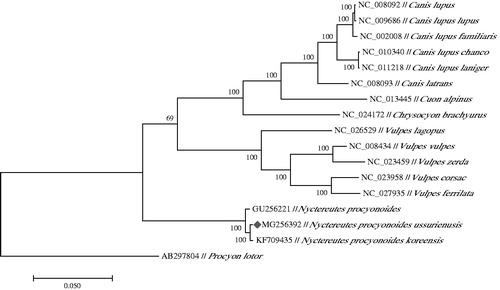Abstract
We determined the complete mitochondrial genome (GenBank accession number: MG256392) of the raccoon dog (Nyctereutes ussurienusis) farmed in Northeast China and compared it with two previously published mitogenomes, one mitogenome of wild raccoon dog captured in Inner Mongolia of China (GenBank accession number: GU256221) and another mitogenome of Korean raccoon dog(GenBank accession number: KF709435). The N. ussurienusis mitogenome is 16,714 bp long and high similarity of 99.2% and 99.1% with Chinese wide raccoon dogs and Korean raccoon dogs. This study will contribute to understanding genetic divergence between raccoon dogs of N. procyonoides in East Asia.
The raccoon dog Nyctereutes procyonoides is native to East Asia and is now widespread in northern and eastern Europe (Mustonen and Nieminen Citation2017). Nyctereutes procyonoides ussurienusis was distinguished from N. p. procyonoides by its larger size and denser, longer hair. Mitochondrial genomes are extensively used for studying population structure and phylogenetic relationships at various taxonomic levels (Saccone et al. Citation1999; Boore et al. Citation2005). In this study, we determined the complete mitochondrial genome of farm bred raccoon dog subspecies N. ussurienusis. And we compared it with two previously published mitogenomes, one mitogenome of wild raccoon dog captured in Inner Mongolia of China (GenBank accession number: GU256221) (Zhang and Chen Citation2010; Chen and Zhang Citation2012) and another mitogenome of Korean raccoon dog (GenBank accession number: KF709435) (Kim et al. Citation2015).
The total length of N. ussurienusis mitogenome is 16,714 bp long with a base composition of 32.08% A, 26.69% C, 14.23% G and 26.98% T, including 13 protein coding genes, two rRNA genes (12S rRNA and 16S rRNA), 22 tRNA genes, a replication origin region (OL) and one control region. Total length of the 13 protein-coding genes are 11,401bp long covering 68.21% of whole mitogenome sequence, all of which are encoded on the same strand except for Nd6 in the light strand. All the 13 protein-coding genes initiate with ATA (Nd2, Nd3 and Nd5) or ATG (Cox1, Cox2, Cox3, ATP6, ATP8, Nd1, Nd4L, Nd4, Nd6 and Cytb). The protein-coding gene of Cytb terminates with AGA, incomplete stop codons of TA + and T++ are found in two (Nd1 and Nd3) and three protein-coding genes (Cox3, Nd2 and Nd4), and the remaining protein-coding genes terminate with TAA. A total length of the 22 tRNA genes is 1,515bp long covering 9% of the mitogenome sequence. The replication origin (OL) is located within the WANCY region containing the cluster of five tRNA genes (tRNATrp, tRNAAla, tRNAAsn, tRNACys and tRNATyr) as seen in most vertebrates (Seutin et al. Citation1994).
High similarity of 99.2% was found between the complete mitogenome sequences of N. ussurienusis and Chinese wide raccoon dogs. The sequence similarity of 99.1% was found in the 13 protein-coding gene regions, 99.7% in the 22 tRNA genes and 97.6% in D-loop regions.
High similarity of 99.1% was found between the complete mitogenome sequences of N. ussurienusis and Korean raccoon dogs. The sequence similarity of 99.6% was found in the 13 protein-coding gene regions, 99.9% in the 22 tRNA genes and 92.4% in D-loop regions.
Phylogenetic analysis included mt genome of N. ussurienusis and the other 15 species that are from the genus Canis, Chrysocyon, Cuon, Vulpes and Nyctereutes, which belong to family Canidae, using Procyon lotor (Procyon) of Procyonidae family as an outgroup. MAFFT (version 7.313) was used for whole-genome alignments. MEGA7 (MEGA Inc., Englewood, NJ) was used to produce the phylogenetic tree. Maximum-likelihood (ML) analysis exhibited that N. ussurienusis clustered with the other two Nyctereutes species highly supported by a bootstrap value of 1000 (). Comparison between mitogenome sequences of N. ussurienusis and the other two raccoon dogs revealed that Asian raccoon dogs are more closely related to each other than previous reports (Kim et al. Citation2015). This study will contribute to understanding genetic divergence between raccoon dogs of N. procyonoides in East Asia.
Acknowledgements
Animal Farm of Institute of Special Wild Animals and Plants in Jilin Province (N40°52′, E121°38′). Samples of DNA involved in this experiment were stored in the Ultra-low temperature freezer of Jilin Provincial Key Laboratory for Molecular Biology of Special Economic Animals.
Disclosure statement
The authors report no conflicts of interest. The authors alone are responsible for the content and writing of the paper.
References
- Boore JL, Macey JR, Medina M. 2005. Sequencing and comparing whole mitochondrial genomes of animals. Methods Enzymol. 395:311–348.
- Chen L, Zhang H-H. 2012. The complete mitochondrial genome and phylogenetic analysis of Nyctereutes procyonoides. Acta Ecol Sin. 32:232–239.
- Kim HR, Cho JY, Park YC. 2015. Intraspecific comparison of complete mitogenome sequences from two Asian raccoon dogs (Canidae: Nyctereutes procyonoides). Mitochondrial DNA. 26:827–828.
- Mustonen AM, Nieminen P. 2017. A review of the physiology of a survival expert of big freeze, deep snow, and an empty stomach: the boreal raccoon dog (Nyctereutes procyonoides). J Compar Physiol B. 188:15–25.
- Saccone C, De Giorgi C, Gissi C, Pesole G, Reyes A. 1999. Evolutionary genomics in Metazoa: the mitochondrial DNA as a model system. Gene. 238:195–209.
- Seutin G, Lang BF, Mindell DP, Morais R. 1994. Evolution of the WANCY region in amniote mitochondrial DNA. Mol Biol Evol. 11: 329–340.
- Zhang H, Chen L. 2010. The complete mitochondrial genome of the raccoon dog. Mitochondrial DNA. 21:59–61.

